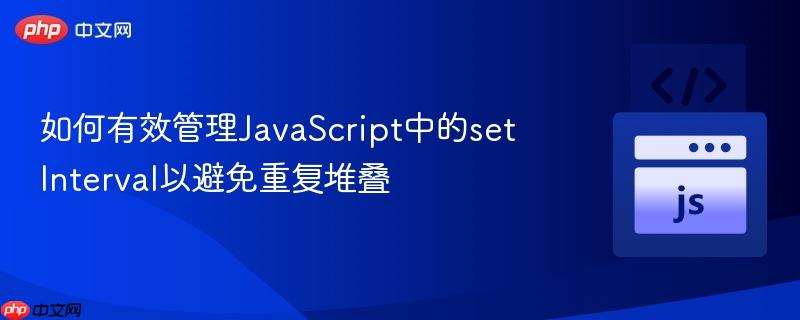
在JavaScript中,setInterval函数用于周期性地执行某个函数或代码块。它返回一个唯一的定时器ID,这个ID可以用于通过clearInterval函数停止定时器。然而,一个常见的陷阱是,当一个包含setInterval的启动函数被多次调用时,如果没有正确管理,可能会导致多个定时器实例同时运行。
考虑以下粒子生成器类示例:
class ParticleGenerator {
constructor(pgPhyEngine, x, y, width, height, particleSizeRange = {
min: 3,
max: 10
}, spawnRate = 100, particlesPerSpawn = 1, velXRange = {
min: -15,
max: 15
}, velYRange = {
min: -15,
max: 15
}, particleColorsArray = ["#ff8000", "#808080"]) {
this.parent = pgPhyEngine;
this.x = x;
this.y = y;
this.width = width;
this.height = height;
this.particleSizeRange = particleSizeRange;
this.velXRange = velXRange;
this.velYRange = velYRange;
this.particleColors = particleColorsArray;
this.spawnRate = spawnRate;
this.spawning = false;
this.particlesPerSpawn = particlesPerSpawn;
// 缺少对 spawnManager 的初始化
}
start() {
// 每次调用都会创建一个新的定时器,并覆盖 this.spawnManager
this.spawnManager = setInterval(() => {
for (var i = 0; i < this.particlesPerSpawn; i++) {
this.parent.createParticle((this.x - this.width / 2) + (random(0, this.width)), (this.y - this.height / 2) + (random(0, this.height)), random(this.particleSizeRange.min, this.particleSizeRange.max), pickRandomItemFromArray(this.particleColors), true, random(this.velXRange.min, this.velXRange.max), random(this.velYRange.min, this.velYRange.max));
}
}, this.spawnRate);
}
stop() {
// 只能清除 this.spawnManager 当前存储的最后一个定时器ID
clearInterval(this.spawnManager);
}
}在这个例子中,如果start()函数被调用了多次,例如:
const generator = new ParticleGenerator(...); generator.start(); // 第一次启动,this.spawnManager = ID1 generator.start(); // 第二次启动,this.spawnManager = ID2 (ID1丢失) generator.start(); // 第三次启动,this.spawnManager = ID3 (ID2丢失) generator.stop(); // 只能清除 ID3
此时,只有最后一次start()调用创建的定时器(ID3)会被stop()函数清除,而之前创建的定时器(ID1和ID2)仍然在后台运行,导致粒子以预期的三倍速度生成。这就是setInterval的堆叠问题。
立即学习“Java免费学习笔记(深入)”;
为了避免setInterval的堆叠问题,核心思想是在每次尝试启动新定时器之前,先检查是否存在一个正在运行的定时器,如果存在,则将其清除。
在类的构造函数中,将用于存储setInterval返回的ID的变量初始化为null。这提供了一个明确的初始状态,方便后续检查。
class ParticleGenerator {
constructor(...) {
// ... 其他属性初始化
this.spawnManager = null; // 初始化为null
}
// ...
}修改start()函数,在创建新的setInterval之前,首先检查this.spawnManager是否为非null。如果它不为null,说明存在一个正在运行的定时器,此时应调用stop()方法将其清除。
class ParticleGenerator {
constructor(pgPhyEngine, x, y, width, height, particleSizeRange = {
min: 3,
max: 10
}, spawnRate = 100, particlesPerSpawn = 1, velXRange = {
min: -15,
max: 15
}, velYRange = {
min: -15,
max: 15
}, particleColorsArray = ["#ff8000", "#808080"]) {
this.parent = pgPhyEngine;
this.x = x;
this.y = y;
this.width = width;
this.height = height;
this.particleSizeRange = particleSizeRange;
this.velXRange = velXRange;
this.velYRange = velYRange;
this.particleColors = particleColorsArray;
this.spawnRate = spawnRate;
this.spawning = false;
this.particlesPerSpawn = particlesPerSpawn;
this.spawnManager = null; // 初始化为null
}
start() {
// 在启动新定时器之前,检查并清除现有定时器
if (this.spawnManager) {
this.stop(); // 调用stop方法清除旧的定时器
}
this.spawnManager = setInterval(() => {
for (var i = 0; i < this.particlesPerSpawn; i++) {
this.parent.createParticle((this.x - this.width / 2) + (random(0, this.width)), (this.y - this.height / 2) + (random(0, this.height)), random(this.particleSizeRange.min, this.particleSizeRange.max), pickRandomItemFromArray(this.particleColors), true, random(this.velXRange.min, this.velXRange.max), random(this.velYRange.min, this.velYRange.max));
}
}, this.spawnRate);
}
stop() {
clearInterval(this.spawnManager);
this.spawnManager = null; // 清除后将ID重置为null,表示当前没有运行的定时器
}
}通过上述修改,start()函数在每次被调用时,会首先检查this.spawnManager。如果它存储了一个有效的定时器ID(即不为null),则会先调用this.stop()来清除旧的定时器。stop()函数在清除定时器后,还会将this.spawnManager重置为null,确保状态的准确性。这样,无论start()函数被调用多少次,都只会有一个setInterval实例在运行。
始终初始化定时器ID: 在类的构造函数或组件的初始状态中,将用于存储定时器ID的变量初始化为null。
配对使用setInterval和clearInterval: 每次调用setInterval后,都应该有一个对应的clearInterval来停止它。在组件卸载、页面离开或不再需要定时器时,务必清除它,以避免内存泄漏和不必要的资源占用。
状态管理: 除了定时器ID,还可以引入一个布尔型变量(如this.isRunning)来明确表示定时器是否正在运行。这可以增强代码的可读性和健壮性。
替代方案:setTimeout递归: 对于需要更精确控制或在每次执行后可能调整延迟的场景,使用setTimeout递归通常比setInterval更灵活和健壮。
function recursiveTimer() {
// 执行你的逻辑
console.log('执行一次');
// 决定是否继续,以及下一次延迟
if (shouldContinue) {
this.spawnManager = setTimeout(recursiveTimer.bind(this), this.spawnRate);
} else {
this.spawnManager = null; // 停止时重置
}
}
// 启动
this.spawnManager = setTimeout(recursiveTimer.bind(this), this.spawnRate);
// 停止
clearTimeout(this.spawnManager);
this.spawnManager = null;这种方式可以避免setInterval可能出现的抖动问题,并且更容易在每次执行后根据条件动态调整下一次执行的时间。
正确管理setInterval是JavaScript开发中的一个重要方面,尤其是在需要周期性任务的复杂应用中。通过在启动新定时器前检查并清除现有定时器,并始终将定时器ID初始化为null,我们可以有效避免setInterval堆叠导致的性能问题和逻辑错误。理解并应用这些模式,能够帮助开发者构建更稳定、高效的Web应用程序。
以上就是如何有效管理JavaScript中的setInterval以避免重复堆叠的详细内容,更多请关注php中文网其它相关文章!

每个人都需要一台速度更快、更稳定的 PC。随着时间的推移,垃圾文件、旧注册表数据和不必要的后台进程会占用资源并降低性能。幸运的是,许多工具可以让 Windows 保持平稳运行。




Copyright 2014-2025 https://www.php.cn/ All Rights Reserved | php.cn | 湘ICP备2023035733号